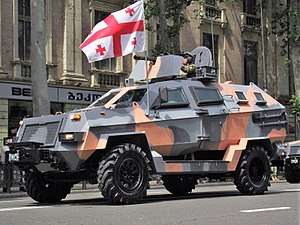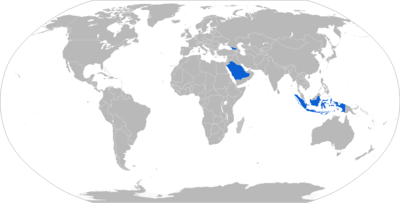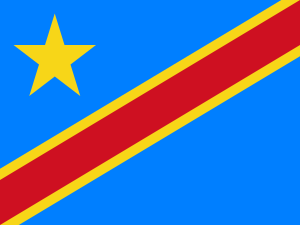Didgori-2
The Didgori-II (Georgian: დიდგორი-II) is an armoured multi-role and special operations vehicle produced by STC Delta. It was developed in 2009 alongside the Didgori-1 using the same internal features with some additional functions. The armoured personnel carrier is thought to provide transport, enhanced visibility and firepower support for infantry troops and SF in various missions including reconnaissance and convoy protection.[1][2][3]
| Didgori-II | |
|---|---|
 Didgori-2 side view during a military parade | |
| Type | Armoured Reconnaissance and Transport |
| Place of origin | |
| Service history | |
| In service | 2011-Present |
| Used by | Operators |
| Production history | |
| Designer | Scientific Technical Center Delta |
| Manufacturer | Scientific Technical Center Delta |
| Specifications | |
| Mass | 8059 kg (combat weight 8855 kg) |
| Crew | 3(2)+6(7) |
Main armament | 7.62×51 mm M134 Minigun or 12.7×108 mm NSV machine gun Optional: RCWS with twinned 12.7 mm and secondary 7.62 mm machineguns |
| Engine | twin turbocharged V8 engine 351 hp |
| Suspension | wheeled 4×4 |
Operational range | 500 km |
| Maximum speed | 120 km/h maximum speed on paved roads 80 km/h off-road 50 km/h with damaged tires |
Specifications and mobility
The Didgori is assembled on and around the chassis of US Ford Super Duty F-550 heavy duty pickup trucks with V8 Power Stroke Turbo Diesel engines and power assisted hydraulic steering. The product basis choice has proven very effective during trials and in the field on various types of terrain.
The max. speed on paved roads is 120–140 km/h and reduced to 80 km/h on terrain. Acceleration from 0–100 km/h is achieved in 22 seconds. The cruising range at 60 km/h is 500 km. Each unit has at least one 20 litre fuel can in reserve. The vehicle can operate at temperatures ranging from -32° to +55° and remains unaffected by heavy meteorological conditions. The wheels consist of Hutchinson 12r20 mpt80 type tyres which have a run flat capability of 50 km at 50 km/h.
The Didgori has 400 mm ground clearance and is able to climb slopes at a 60% gradient and drive sideways along a slope at a 40% gradient. The vehicle base version is not amphibious - although such a variant is an option, but can move in up to 1 m deep water.[4][5]
Saudi Arabian trials
On 27 August 2014, Georgia participated with a MedEvac prototype in a tender for armoured personnel carriers hosted by the Ministry of Defence of Saudi Arabia. The tests were carried out mostly in the Arabian desert but also urban areas and included movement on different altitudes - mountains, various types of terrain and gradients, weather conditions, under extreme stress and maximum weight burden at top speed. The trials culminated in a 40 km simulated fully loaded evacuation at maximum speed.
The Didgori passed every test with very good results and made it to the finals alongside the American Lenco BearCat after eliminating four other competing vehicles, including the American Oshkosh M-ATV. Even though the Didgori also showed better results than its American finalist counterpart in every aspect, the winner was not announced earlier than January 2016, after months of consulting and evaluation. The Saudi Arabian tender was a very important event to test the vehicle's capabilities in extreme conditions, particularly in a desert environment.
DELTA consequently made necessary adjustments and changes for both its export and home products.
Electronic equipment
Every base variant is equipped with thermal imaging and night vision FLIR Systems attached to the front and rear end, as well as underneath the hull on each side. Information from the cameras is displayed on three monitors: one for the driver, one for the commander and one for the passengers. A special navigation system GPS is installed on the vehicle in order to provide additional information via short message service (SMS) to the crew. The system works in any meteorological condition contrary to other GPS systems.
According to the developer, the vehicle can operate at full capacity in an environment with temperatures ranging from -32 °C to +55 °C without damaging the electronics. All systems operate on 24V DC on a 200 amp alternator with a 78amp/hr battery. The vehicle has no standard issue radio mount thus can be equipped according to army requirements or customer preferences.[6]
Armament
The standard main armament consists of a M134 minigun mount, open turret drive shafts rotational unit - external or air flow. The firing rate can be adjusted from 300 to 6,000 rounds per minute. Total mount weight is 22.7 kg without the ammunition feed system. Primary ordnance is the 7.62×51mm NATO. Ammunition capacity can range from 1,500 (total weight 58 kg) to 4,500 (total weight 134 kg) rounds. Optionally the standard armament can be a 12.7×108 mm DShK or NSV machine gun.
The latest variants have DRWS-1 remote weapon stations equipped with twinned 12.7 mm machineguns and one 7.62 mm lmg attached.[7] Alternatively grenade launchers, ATGMs and short range low-altitude air defence systems can be fitted on the vehicle.
Protection
Depending on build and in combination with the vehicle's angled design, which is described as monocoque, Didgoris can offer either STANAG 4569 level II or level III protection against small arms fire, including 7.62x39 mm and 7.62x54 mm AP / steel core rounds. The engine and crew compartment areas are encased in double armour layers and withstand mines and other explosives in accordance with STANAG 4569 Level 2A.
The crew seats are specially designed to absorb blasts. Didgoris are equipped with run-flat tires, enabling them to drive on with damaged tires a distance of 50 km at 50 km/h maximum speed. Additionally, a central tire inflation system can be installed to further increase their survivability. All four wheel flanges are ballistic.
The exact composition of the armour material is classified.[8][9]
Variants

Civilian use
A number of unarmed variants of the Didgori are deployed in several regions of Georgia as cloud dispersal units which have DELTA manufactured "CD-56" hail suppression system mounted on them. They are linked to regional weather surveying spheres automatically initializing hail suppression procedures if a hailstorm is imminent.
Operators




Gallery
References
- http://delta.gov.ge/file/2015/04/Didgori_STC_Delta_Production-Catalogue_01.01.2015.pdf
- http://www.military-today.com/apc/didgori.htm
- http://www.army-technology.com/projects/didgori-apc/%5B%5D
- http://delta.gov.ge/wp-content/uploads/2015/04/Didgori_STC_Delta_Production-Catalogue_01.01.2015.pdf
- http://delta.gov.ge/en/product/didgori/
- http://delta.gov.ge/wp-content/uploads/2015/04/Didgori_STC_Delta_Production-Catalogue_01.01.2015.pdf
- http://delta.gov.ge/file/2015/01/drws-1.pdf
- http://delta.gov.ge/en/product/didgori/
- http://delta.gov.ge/wp-content/uploads/2015/04/Didgori_STC_Delta_Production-Catalogue_01.01.2015.pdf
- http://delta.gov.ge/en/product/communication-vehicle/
- http://delta.gov.ge/en/product/medical-evacuation-vehicle/
- "Archived copy". Archived from the original on 1 July 2015. Retrieved 5 July 2015.CS1 maint: archived copy as title (link)
- "Archived copy". Archived from the original on 5 July 2015. Retrieved 5 July 2015.CS1 maint: archived copy as title (link)
- http://en.azeridefence.com/georgia-prepares-to-ship-the-first-lot-of-armored-transporters-to-saudi-arabia/
- http://1tv.ge/ge/news/view/116347.html
- "Archived copy". Archived from the original on 15 January 2017. Retrieved 26 January 2016.CS1 maint: archived copy as title (link)
- http://dfwatch.net/georgia-to-supply-armored-medevac-vehicles-to-saudi-arabia-39899
- https://jakartagreater.com/219420/georgia-mulai-produksi-amev-didgori-pesanan-indonesia/
- https://militermeter.com/diam-diam-indonesia-beli-ambulan-lapis-baja-amev-didgori-dari-georgia/
External links
| Wikimedia Commons has media related to Didgori-2. |







.jpg)
